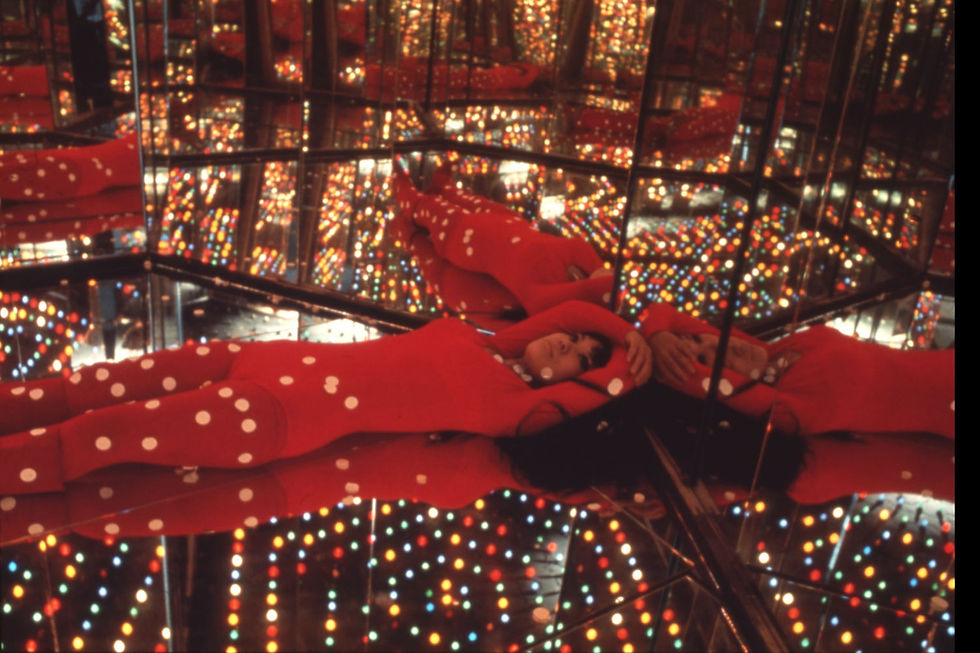Yayoi Kusama, her art, + youtube video
- gerard van weyenbergh
- Mar 24, 2021
- 3 min read
In short
Priestess of total, hypnotic and colorful art, the Japanese Yayoi Kusama (born in 1929) is known worldwide for her impressive immersive installations. She is also an iconic figure of the hippie years. Touched by an obsessive disorder, she declines the polka dots endlessly, completely invading the space. With an eccentric personality, the artist also marked the 1960s with her nudity performances and the freedom to enjoy one's body. Since 1973, she has lived in a psychiatric hospital in Japan and continues to create abstract works marked by the accumulation principle.
She said
"My life is a pea lost among millions of other peas. "
Her life
Yayoi Kusama was born in traditional Japan in the 1920s. Very early on, the little girl took an interest in art and drawing. Her family suffered the full brunt of the consequences of World War II, and Yayoi Kusama was mobilized for the war effort: she produced parachutes and military clothing in a factory.
Marked by the figure of a very authoritarian father, the young girl is in the grip of an obsessive delirium, suffering from visual hallucinations. Despite her parents' opposition, she studied art and began to exhibit her work, although few women were elevated to the rank of artists in conservative Japan. She makes the principle of accumulation the mainspring of her work and the polka dot ( polka dot ) her favorite motif.
Supported by American artist Georgia O'Keeffe, Yayoi Kusama arrived in the United States in 1957. Thanks to her new circle of friends, in particular Donald Judd, she exhibited and designed installations in the early 1960s. She created populated environments ad nausea in phallic and soft shapes, made with sheets or old socks. Her works are extremely psychedelic.
From 1966, Yayoi Kusama became popular in the United States, organized performances and happenings in emblematic places in New York: at the Museum of Modern Art, at the Stock Exchange, or the Statue of Liberty. These actions are often sources of scandal because of the nudity of the participants. As a result, Yayoi Kusama is regularly accompanied by her lawyer. Nudity takes on a political meaning: the artist campaigns for sexual freedom, women's right to dispose of their bodies, spiritual liberation.
In her performances, Yayoi Kusama rarely stages herself but uses the bodies of others. It is based particularly on butō, an avant-garde Japanese choreographic art, created just after WWII and which slowly explores the body's specificities. Fashion and design have always interested her, she also creates polka-dot clothing, the aesthetic of which is inspired by traditional Japanese clothing.
After a period of strong media coverage, the artist experienced a slowdown in her career in the 1970s. Back in Japan, she has been living since 1977 (and at her request) in a psychiatric establishment, only leaving to work in her studio.
The 1980s brought the artist back to the forefront as a great avant-garde figure. She was invited to represent Japan at the Venice Biennale in 1993. Her work has since been the subject of major retrospectives around the world, attracting crowds of visitors, particularly seduced by its "infinite" environments, invaded by peas, bright diodes, balloons, or psychedelic patterns. Since 2017, a museum has been dedicated to him in the city of Tokyo.
Her key works

My Flower Bed , 1962
This work illustrates the principle of accumulation chosen by Yayoi Kusama in the 1960s. By accumulating forms, often soft, the artist strives to control his anxiety and presents her work as therapy. According to her, it is a way of reconnecting with nature: "Full of loneliness, unable to sleep, I curl up in my Flower Bed for the night, because the flowers are soft and loving. I am like an insect which returns to its flower for the night; the petals close around me like the mother's womb protects the unborn child".

Aggregation: One thousand Boats show, 1963
In 1963, her installation Aggregation: One Thousand Boats Show at the Stein Gallery impressed Andy Warhol, the pope. It consisted of a monochrome boat entirely covered with phallic shapes which seem to have colonized the object, leaving a strange impression of invasion. The phallic shape, which symbolizes masculinity and fertility, covers a sacred dimension in Japanese culture (the phallus is also for Yayoi Kusama an evocation of the god Jizō).

Peep Show or Endless Love Show, 1966
Yayoi Kusama revisits here one of the devices associated with eroticism and pornography. It is a hexagonal space whose mirrored surfaces endlessly reflect the luminous device, to the sound of the Beatles song Help , broadcast in a loop. The spectator can only pass through the face, placed in the position of the voyeur or the client. This work foreshadows the Infinity Mirror Rooms, rooms entirely covered with mirrors multiplying endless patterns, which have made it famous worldwide today. © Beaux-Arts Magazine




Commentaires